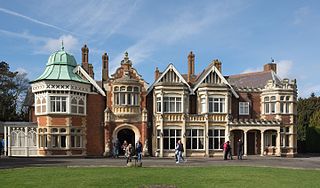
Bletchley Park is an English country house and estate in Bletchley, Milton Keynes (Buckinghamshire) that became the principal centre of Allied code-breaking during the Second World War. The mansion was constructed during the years following 1883 for the financier and politician Sir Herbert Leon in the Victorian Gothic, Tudor, and Dutch Baroque styles, on the site of older buildings of the same name.

Ultra was the designation adopted by British military intelligence in June 1941 for wartime signals intelligence obtained by breaking high-level encrypted enemy radio and teleprinter communications at the Government Code and Cypher School (GC&CS) at Bletchley Park. Ultra eventually became the standard designation among the western Allies for all such intelligence. The name arose because the intelligence obtained was considered more important than that designated by the highest British security classification then used and so was regarded as being Ultra Secret. Several other cryptonyms had been used for such intelligence.

The bombe was an electro-mechanical device used by British cryptologists to help decipher German Enigma-machine-encrypted secret messages during World War II. The US Navy and US Army later produced their own machines to the same functional specification, albeit engineered differently both from each other and from Polish and British bombes.
Cryptanalysis of the Enigma ciphering system enabled the western Allies in World War II to read substantial amounts of Morse-coded radio communications of the Axis powers that had been enciphered using Enigma machines. This yielded military intelligence which, along with that from other decrypted Axis radio and teleprinter transmissions, was given the codename Ultra.

Hut 8 was a section in the Government Code and Cypher School (GC&CS) at Bletchley Park tasked with solving German naval (Kriegsmarine) Enigma messages. The section was led initially by Alan Turing. He was succeeded in November 1942 by his deputy, Hugh Alexander. Patrick Mahon succeeded Alexander in September 1944.
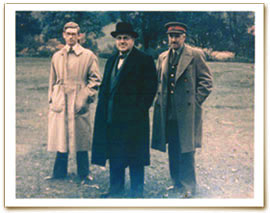
Sir Francis Harry Hinsley, was an English historian and intelligence officer. He worked at Bletchley Park during the Second World War and wrote widely on the history of international relations and British Intelligence during the Second World War. He was known as Harry Hinsley.
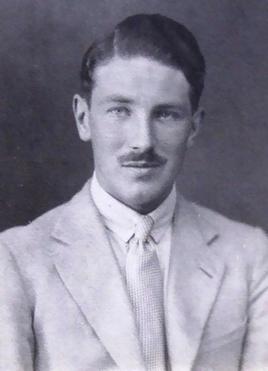
William Gordon Welchman OBE was a British mathematician. During World War II, he worked at Britain's secret decryption centre at Bletchley Park, where he was one of the most important contributors.
Commander Alexander "Alastair" Guthrie Denniston was a Scottish codebreaker in Room 40, deputy head of the Government Code and Cypher School (GC&CS) and hockey player. Denniston was appointed operational head of GC&CS in 1919 and remained so until February 1942.

Hut 6 was a wartime section of the Government Code and Cypher School (GC&CS) at Bletchley Park, Buckinghamshire, Britain, tasked with the solution of German Army and Air Force Enigma machine cyphers. Hut 8, by contrast, attacked Naval Enigma. Hut 6 was established at the initiative of Gordon Welchman, and was run initially by Welchman and fellow Cambridge mathematician John Jeffreys.
John William Jamieson Herivel was a British science historian and World War II codebreaker at Bletchley Park.

Sir Philip Stuart Milner-Barry was a British chess player, chess writer, World War II codebreaker and civil servant. He represented England in chess both before and after World War II. He worked at Bletchley Park during World War II, and was head of "Hut 6", a section responsible for deciphering messages which had been encrypted using the German Enigma machine. He was one of four leading codebreakers at Bletchley to petition the then-Prime Minister Winston Churchill directly for more resources for their work. After the war he worked in the Treasury, and later administered the British honours system. In chess, he represented England in international tournaments, and lent his name to four opening variations.
Sir Eric Malcolm Jones was a British intelligence officer who was director of the British signals intelligence agency, GCHQ from 1952 to 1960.

John Robert Fisher Jeffreys was a British mathematician and World War II codebreaker.
Hugh Rose Foss was a British cryptanalyst. At Bletchley Park during World War II he made significant contributions both to the breaking of the German Enigma code and headed the section tasked with breaking Japanese Naval codes.
Keith Batey was a codebreaker who, with his wife, Mavis Batey, worked on the German Enigma machine at Bletchley Park during World War II.
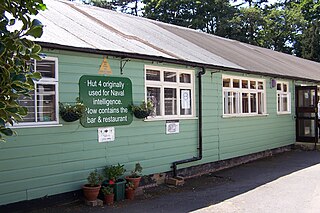
Hut 4 was a wartime section of the Government Code and Cypher School (GC&CS) at Bletchley Park tasked with the translation, interpretation and distribution of Kriegsmarine messages deciphered by Hut 8. The messages were largely encrypted by Enigma machines. As the Kriegsmarine operated Enigma more securely, Hut 8 had less information for Ultra than Hut 6 which handled Army and Air Force messages. Hut 4 also broke various hand cyphers and some Italian naval traffic.
Dennis William Babbage OBE was an English mathematician associated with Magdalene College, Cambridge, and with codebreaking at Bletchley Park during World War II.
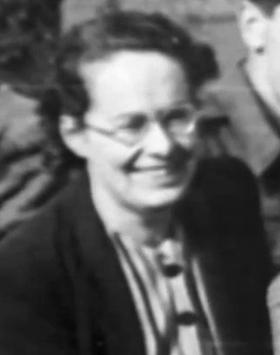
Joan Elisabeth Lowther Murray, MBE was an English cryptanalyst and numismatist who worked as a code-breaker at Bletchley Park during the Second World War. Although she did not personally seek the spotlight, her role in the Enigma project that decrypted the German secret communications earned her awards and citations, such as appointment as a Member of the Order of the British Empire (MBE), in 1946.
Action This Day was a 1941 memorandum sent to Winston Churchill personally, as the Bletchley Park (BP) codebreaking establishment was short of staff in some critical areas. Their requirements were small, but as a small organisation their management did not have priority. Four senior heads of sections ("Huts") and their deputies wrote to Churchill, who had visited "BP" on 6 September 1941, where he made a speech saying he appreciated their work.











